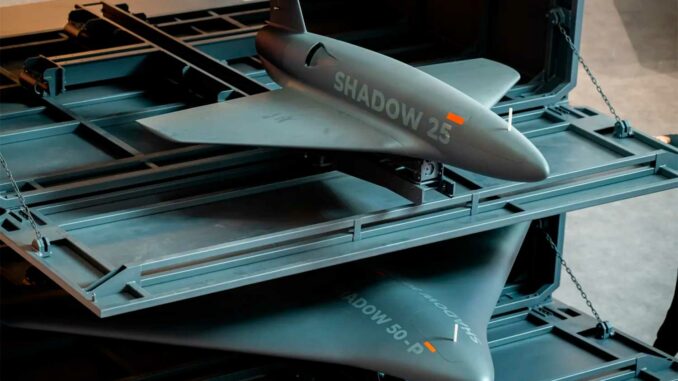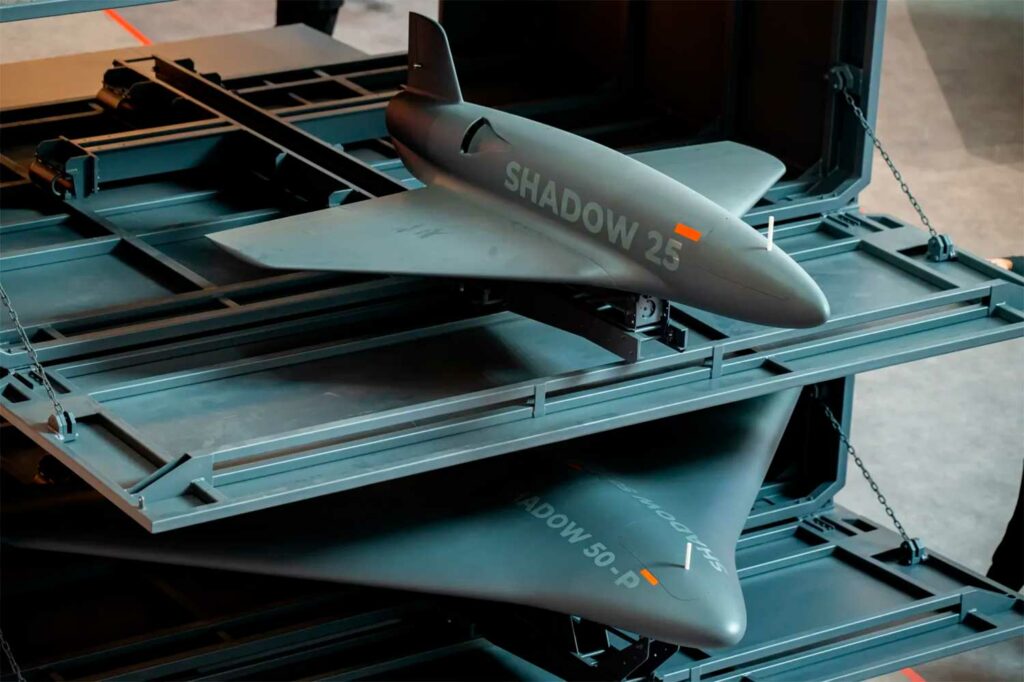
The EDGE Group, through ADASI, launches SHADOW 25 and 50, cost-effective loitering munitions with long range and enhanced precision.
Summary
The EDGE Group (United Arab Emirates), through its subsidiary ADASI, unveils the SHADOW 25 and 50 loitering munitions range, designed for striking fixed targets at long range and at a contained cost. The SHADOW 25 model carries up to 25 kg of payload, has a cruising speed of 400 km/h (≈216 knots) and a maximum range of 295 km. The SHADOW 50 version supports up to 50 kg of payload, has an endurance of up to 9 hours, and the same range. These systems incorporate GNSS guidance, visual and video navigation, and the ability to operate in GPS-degraded environments. The contract signed with the UAE Armed Forces is worth approximately AED 1.33 billion (≈$370 million). This offer positions EDGE as a significant player in the precision strike loitering munitions market, competing with Israeli and Turkish systems. Both tactical and industrial impact: a cost-optimized tool for minimal target engagement, and increased sovereignty for customers.
What is “loitering” munition?
A loitering munition is an autonomous or remotely piloted aerial vehicle designed to loiter over a target area, detect a target, and sacrifice itself by impacting it to destroy it. It is sometimes referred to as a kamikaze drone, but this term oversimplifies a broader technical and operational range.
Definition and operating principle
A loitering munition combines the capabilities of a drone and a cruise missile. After being launched from a container, land vehicle, naval platform, or aircraft, it “loiters”—that is, it remains in flight over an area for a variable period of time—to search for, identify, and strike a fixed or specific target. The final decision to strike can be made automatically by the device (autonomous) or validated by a human operator (human-in-the-loop).
Key technical components
- Propulsion and structure: piston engine, turboprop or mini turbojet depending on endurance and speed. Typical takeoff weight: tens to hundreds of kilograms; typical explosive payload: 5–50 kg depending on the family.
- Guidance & navigation: GNSS/INS combinations (GPS/GLONASS + inertial navigation system), optical navigation and vision systems (EO/IR camera) for reconnaissance and identification.
- Communication: encrypted data link for video feedback, telemetry, and manual control. Link range: tens to hundreds of kilometers depending on architecture (satellite, airborne relay, line-of-sight).
- Payload and warhead: fragmentation, penetrating or thermobaric warheads depending on the target. The payload capacity determines the terminal effect.
- Onboard systems: detection sensors, imaging filters, identification algorithms, navigation capabilities in degraded environments (GNSS jamming).
Operational modes of use
- Search and scheduled strike: the munition follows a predefined area and strikes a known target after confirmation.
- Active surveillance then strike: it monitors the area, identifies a target of opportunity (vehicle, radar) and strikes when the rules of engagement are met.
- Persistent support: used to maintain a low-cost aerial presence over an area (e.g., to prohibit the use of a runway or neutralize a radar upon detection).
Tactical advantages
- Endurance and patience: the ability to remain in flight for several hours increases the probability of intercepting a temporary target.
- Cost/effectiveness: less expensive than a high-end missile or a manned aircraft sortie for certain specific missions.
- Accuracy: optical and GNSS guidance allows for high accuracy on fixed targets.
- Reduced human risk: no exposed crew.
Differences from other systems
- Compared to UCAVs (Unmanned Combat Aerial Vehicles): UCAVs are often reusable, multi-mission, and can return after use. Loitering munitions are generally consumable (single attack).
- Compared to cruise missiles: missiles are launched at a known target without a prolonged search phase. Loitering munitions combine persistent search and strike capabilities.
Examples and typical capabilities
Well-known systems include Harop (Israel Aerospace Industries), Switchblade (United States), and Kargu (Turkey). Characteristics vary: range from tens to hundreds of kilometers, endurance from tens of minutes to several hours, payloads from a few kilograms to tens of kilograms.
Countermeasures and vulnerabilities
- GNSS jamming/spoofing: can degrade navigation if the munition does not have robust INS redundancy or visual navigation.
- Electronic warfare: jamming of data links can prevent human confirmation and force less reliable autonomy.
- Active defense: C-RAM systems, short-range air defense, and kinetic fire intercept loitering munitions.
- Counter-detection: electro-optical sensors can be fooled by decoys or smoke screens.
Legal and ethical issues
Loitering munitions raise questions related to compliance with international humanitarian law: positive identification of targets, proportionality, and accountability in the event of error. The use of autonomy in the final phase—letting the munition decide on impact without human intervention—is particularly sensitive and raises normative debates.
Limitations and optimal conditions of use
They are particularly suitable against fixed or specific high-value targets (radars, depots, high-value vehicles) and in environments where electromagnetic dominance is assured or navigation is redundant. They are less suitable for operations in areas that are heavily contested by dense air defenses or subject to strict legal constraints.

The EDGE Group and its subsidiary ADASI: context and positioning
The EDGE Group is a defense conglomerate based in the United Arab Emirates, formally created in November 2019 from the merger of several previous entities. It employs several thousand people and comprises more than 25 companies active in defense technologies, including drones, smart munitions, and autonomous systems. The subsidiary ADASI (Advanced Defense & Aerospace Systems) specializes in autonomous systems and unmanned aerial vehicles (UAVs) for surveillance, attack, and strike missions. The launch of SHADOW munitions is part of EDGE’s strategy to become a global supplier of high value-added systems and reduce dependence on Western suppliers. In 2022-2023, EDGE announced that its orders had exceeded $5 billion, with a growing share of exports. This growth is a strong signal that the company is evolving from a regional role to competing in the international smart weapons market.
The SHADOW 25 and 50 range: technical specifications and technology
The SHADOW 25 loitering munition is a fixed-wing, jet-powered vehicle designed for precise strikes on stationary targets. It has a payload of 25 kg, a cruising speed of 400 km/h, a maximum range of 295 km, a maximum take-off weight (MTOW) of 90 kg, a wingspan of 2.15 m, and a length of 2.25 m. It can be launched from a container or by pneumatic rocket booster. It features GNSS guidance, visual navigation, on-board optical navigation, and a data link of up to 100 km. It flies at a ceiling of approximately 6,100 m (20,000 ft).
The SHADOW 50-P version offers a payload of 50 kg, an endurance of up to 9 hours, a range of 295 km, an MTOW of 125 kg, a wingspan of 3.47 m, a more moderate cruising speed (~167 km/h according to some sources) but an ability to remain in the area for longer. These systems represent a category of long-endurance loitering munitions: they can fly over the target area, wait or search for the right moment, and then strike. This technology combines the qualities of cruise missiles (range, payload) and kamikaze munitions (self-destruction on target): they are optimized for effective one-off strikes at a lower cost than piloted aircraft or high-end missiles. SHADOW 25/50 differ in their balanced approach between speed/reaction time (25) and endurance/contact surface (50).
Operational use: how it works and what effects it has
Operating SHADOW munitions involves several phases: preparation (mission planning, selection of fixed targets), launch from a container or adapted system (land or sea-based), flight or “cruising” phase in the target area, guidance (GNSS, optical, visual), and final impact. For example, a SHADOW 25 launched towards a target 250 km away could fly at ~400 km/h, arrive in 37-38 minutes, perform visual detection/confirmation of the target, and then dive/stick. The key advantage is increased accuracy (thanks to optical navigation) and a lower cost than heavy missiles. The SHADOW 50, with its 9-hour endurance, can remain in flight for a very long time, monitor movements, wait for a valuable object to appear, and then strike. This allows for tactical flexibility and the ability to strike high-value fixed targets with minimal platform exposure. In terms of tactical effect, loitering munitions reduce the target’s window of opportunity, increase the element of surprise, and limit the exposure of piloted systems or expensive aircraft. The containerized format also allows for advanced deployment or deployment on ships/mobile platforms, reducing reaction time.
Positioning against the competition and the global market
Several major players stand out in the global loitering munitions market: Israel (IAI Harop), Turkey (STM Kargu, Alpagu), and the United States (Switchblade, among others). The SHADOW 25/50 range developed by EDGE/ADASI is competitively positioned, combining range, payload, and cost. The contract with the UAE Armed Forces, worth approximately AED 1.33 billion (≈USD 370 million) for SHADOW 25/50, is proof of market demand. The 50 kg payload for the SHADOW 50 version is particularly high in this category, bringing it closer to light missiles.
The export market represents a significant opportunity for EDGE: by not relying on components subject to US restrictions, the company can offer solutions to countries subject to embargoes or Western technology restrictions. In addition, the system’s modularity and containerization make it attractive to forces seeking a discreet and versatile strike range. However, competition remains fierce in the areas of stealth, embedded artificial intelligence, drone swarms, and electronic warfare. EDGE must therefore evolve to remain competitive.
Strategic and industrial impacts
The introduction of SHADOW 25/50 munitions has several implications. Strategically, it provides purchasing forces with a low-cost, fast, and accurate strike capability, which increases pressure on potential adversaries and lowers the barriers to entry for high-value air strikes. This shifts the regional balance of power, particularly in the Gulf and Asia-Pacific, where investment in technological autonomy is growing. Industrially, EDGE is strengthening its position in the smart and autonomous weapons segment. The local development of loitering munitions reinforces the UAE’s autonomy and may create export chains to allies or third-party customers. This stimulates research into autonomous guidance, propulsion, composite materials, and rapid, containerized launch systems. The fact that SHADOW 25 uses a jet engine also indicates an advanced level of technology for this type of munition.
Conditions for success and challenges to be overcome
For the SHADOW 25/50 project to deliver on its promises, several conditions must be met. First, technological maturity: optical and visual guidance, navigation in GPS-degraded or prohibited environments, flight robustness, and engine and weapon system reliability. Second, the unit cost must remain competitive for the business model to be viable: if the munition is too expensive, it loses its “cost-containment” advantage. Third, integration within the forces: training, doctrine of use, logistics, maintenance, launch chain. Fourthly, international regulations: loitering munitions raise ethical and legal questions regarding autonomous targeting, which could limit certain customers. Finally, technological competition is forcing EDGE to accelerate research into embedded AI, swarms, jamming coverage, and counter-drone systems.
EDGE’s SHADOW 25/50 program via ADASI illustrates the rapid evolution of autonomous, cost-optimized strike weapons. It could well redefine long-range precision strike for forces attracted by flexibility and economy. It remains to be seen whether production, operational integration, and export will meet expectations.
War Wings Daily is an independant magazine.